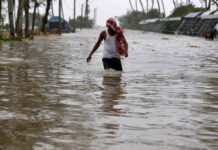NEW DELHI: From optimising peak potable water production to 916MGD to installing hundreds of tubewells in water-scarce regions, the Delhi Jal Board has announced a host of measures to deal with rising demand in the light of rising temperatures. “We are targeting a peak production of 916MGD of potable water by optimising all resources during summer. Normally, our combined capacity is around 900MGD,” a senior DJB official said.
Under the summer plan, 149 new tubewells will be installed in water-strained areas. These will be part of a total 4,460 tubewells that will be in operation during the next three months. “These tubewells will help us augment water supply in case of an emergency,” the official said.

arts of the capital are already grappling with a crisis of sorts. In March, a confrontation over water sharing had led to the death of a senior citizen in northwest Delhi’s Wazirpur. A month later, the man’s son, too, succumbed to injuries sustained in the scuffle. DJB claims to have upgraded its water treatment plants and replaced old pumps and panels. “Stock positions of disinfectants, spare parts and coagulants have been reviewed to ensure all facilities continue to work at full potential,” the official quoted above said.
In keeping with AAP government’s focus on improving supply in unauthorised colonies, villages and JJ clusters, the summer plan proposes to press into action several new underground reservoirs and an nearly a 1,000 water tankers in these areas. “The underground reservoir in Karala (under Bawana region), which will benefit 5.4 lakh residents, will be commissioned by this month-end. The Mayapuri UGR, with a capacity of 12.5ml, and phase-I of the UGR at Dichaon Kalan, too, will be made operational this summer,” the official said.
Additionally, the board has set up a target of laying down 302km of new water pipelines and replacing 298km of old faulty ones before the onset of the peak season.
If the first three months of the year are anything to go by, the capital may face a dry and water-strained summer this time around. The ammonia level, which ideally should be nil, crossed 2ppm early in the year. “The Panipat dye drain was bringing all untreated industrial waste into the Yamuna pond due to which colour, chloride, hardness as well as ammonia levels increased. We can manage other impurities, but the colour and ammonia levels are beyond acceptable limits,” a senior DJB official said.
With March seeing an average shortfall of 60-70 MGD on a daily basis, DJB had moved the Supreme Court for directions to the Haryana government to restore normal water release.
Officials claimed that necessary upgrades were now in place to address the frequent problem of increased ammonia levels in the Wazirabad pond, which had earlier resulted in the partial closure of Wazirabad, Chandrawal and Okhla WTPs. “These plants won’t be shut down even if ammonia levels touch 0.9ppm for a prolonged period. Continuous monitoring will be carried out with Haryana to prevent a shutdown,” the plan stated.
Welcome!Log into your account

 India
India





















